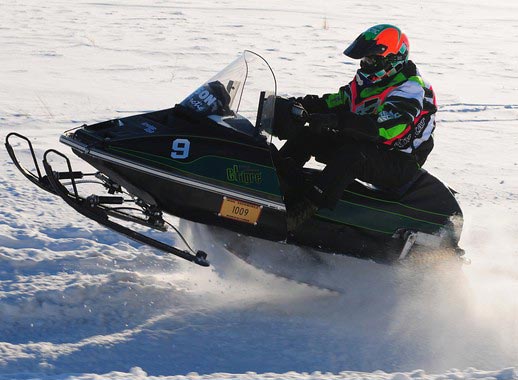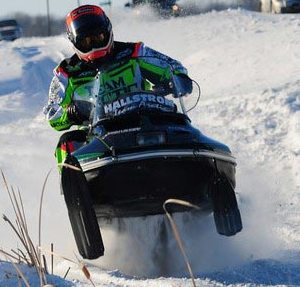
The first-ever Vintage I-500 project is complete, culminating in the actual race last weekend. But first, a quick summary:
Upon hearing the news that there would be a Vintage class in this year’s USCC I-500, my good friend Brian Nelson started collecting 1979 Arctic Cat el tigre Cross-Country Cats last spring. He started building one. Brian then asked Joey Hallstrom if he also wanted a sled to race. And in September, when he’d accumulated still more sleds and parts, Brian asked me if I also wanted to race.
You can read the series of stories about building the sleds.
And now, onto the race recap:
Race weekend in TRF began cold, with temps in the minus-teens. Last minute sled preparation in Nelson’s trailer included changing studs, adding some wind deflectors to a couple windshields and final bolt/nut checks. Below, Joey Hallstrom, young Jesse Hallstrom and Enduro Team Deere veteran Tom Otte do some detail work on Joey’s sled.
The three of us went for a final scoot on Friday, just for peace of mind. One thing was apparent: With upwards of 4-plus feet of snow in the ditches, and the fact that 125 modern sleds were starting before us vintage leafers, we would have a brutally-rough race course to contend with. I like rough courses, so I was pumped.
Unloading the sleds from Nelson’s race trailer for a final test ride.
The night before the race, Joey (left), Hubert Fixsen (middle) and Brian Nelson share a laugh about what they’ve experienced during the past few decades, and that despite it all… here they were on the eve of another I-500, talking gearing, studding, shock calibration, goggle prep, race strategy, fuel stops, etc…
Such conversations never get old for me, and I always feel lucky to hear them.
It was also very cool to see the steady stream of famous and not-famous vintage racers throughout the day. Guys like Doug Oster, Jon Carlson, Tom Otte, Steve Tabor, Archie Simonson, Aaron Scheele as well as people whose names I only vaguely recognized, or didn’t know at all.
Vintage nuts like Joe Rainville, Jessie Bablers and dozens of others came to see Nelson and talk about last-minute decisions, all of which added to the anticipation of what was to come.
Saturday morning was crisp and, most importantly for all the age-challenged eyes, clear! Here Brian Nelso re-creates his famous 1978 I-500 starting line shot for cameraman Jim Urquhart.
Let me say this right now: Brian Nelson jumped into this entire project with the same focus, determination and attention to detail that he plied as a Factory Arctic Cat racer back in the late 1970s. And he was just as determined to win.
I knew from the weeks of testing with Brian, they he would be blistering-fast. And sure enough, when the green flag dropped he nailed it like it was 1978, Day 4.
The pictures don’t due justice to the roughness of the course. There were ditch sections with 4-6-foot moguls. When the course was on the Warren, Minn., loop, there were miles upon miles of square-edged, windblown drifts that pounded our suspensions and backs to a degree that is hard to describe.
For Brian, this constant pounding on a worn and tattered back would prove extra-tough, and he had to back the pace down to compensate.
Meanwhile, Joey Hallstrom was racing a fast, smart pace. He too was there to win, and when he caught Nelson before the second fuel stop, Joey put himself ahead on time.
My own race was flowing excellent. My strategy was to have a fast-trail-riding-pace for the first 55 miles. Then, after the first fuel stop, gradually ramp up my speed to a full race pace.
I was careful not to crash, or to wear myself out on the first leg. I expected that the middle and late portions of the day would ultimately determine the winner, and I wanted to be fresh and ready to challenge.
But racing has a way of foiling our best-laid plans. About five miles from the second fuel stop, at roughly the 110 mile mark, my engine seized. It’s a terrible sound, because of what it meant for my race.
This was my fifth I-500 going back to 1991, and I’d finished the previous four. On the one hand I feel fortunate to have finished the first four. But on the other, I feel the sharp sting of disappointment. Knowing the hours of work put into my sled, the days spent away from home and family, and the sheer thrill of what it’s like to see the finish line in this race… all of it seized with the crank bearing.
I wasn’t the only one to suffer a DNF. Of the 31 Vintage class entrants, only nine would ultimately finish.
One of my fellow DNFers was legendary Team Arctic racer, Aaron Scheele (above).
Scheele too put his heart and soul into preparing his sled and body for this year’s race. He started directly behind me and, when he went past me just three miles into the race, at a speed that made my head spin, I knew who would be the fastest vintage racer on the course this day.
Starting 17th, Scheele caught and passed Nelson (who started second), just before the first gas stop. Spectators and friends would tell me after the race that Scheele was passing modern sleds, which didn’t surprise me in the least. His 1979 el tigre was prepped as well as any in the race. It was clutched by his friend Jim Dimmerman. And Aaron has always been one of the fastest racers in the world.
Scheele’s day came to an end about 400-yards from where mine ended. While he hasn’t yet fully diagnosed the problem as I write this, he suspects it was also a crank bearing on his 440 liquid engine.
Hallstrom was having no such bad luck, and when he came into the second and final fuel stop, he knew he could back it down a notch.
I wish this photo better highlighted some of our key help for the weekend. Dave Nehring, Joe Steffen and Alan Berger took several days “out” of their lives to help us race, fuel our sleds, offer every kind of helpful support and even pick up a DNF sled/driver (me). And I was too busy to get a decent photo of them (sorry guys).
Success in racing happens for many reasons, and one of them is the often-unheralded support of people like these guys. While they share little in the limelight, they are critically-important to any race effort.
A HUGE “Thank You” to the three of you, and to Karen Nelson, Michelle Steffen and Tom White!
With just a few miles to the finish line at the Seven Clans Casino, Brian Nelson was still smoking-fast. This shot, like nearly all of those in this post, was captured by Jim Urquhart, and highlights the stunning beauty of the Arctic Cat el tigre CC Cat.
Hallstrom rode the perfect race, finding that sweet-spot pace that combined speed, smart line choice and zero mistakes. Hallstrom has raced many I-500s in his career, going back to the 1979 event. And while I love to tease him about road running, I appreciate greatly that he rode a near-flawless race, and that he won the first vintage I-500 race.
Check out this cool video of Hallstrom, shot by Nick Carlson. (Seriously, this section of course absolutely does NOT illustrate how rough the other 160 miles were.)
When the times were tallied, Hallstrom (left) won the day, with Nelson (middle) in second and Joey Potucek in third. All three were on ’79 el tigre Cross-Country Cats, which was a nice sight for us Cat fans.
After the awards banquet, there were lots of laughs and bench-racing stories. Here Roger Skime poses with Nelson. Skime thought we were nuts to race the old iron.
I want to thank the USCC for hosting this incredible event. I wouldn’t be surprised if we have 70 vintage entries next season.
I also want to thank and congratulate all the vintage racers, crew and fans who made this event a rousing success.
It was such a joy to see vintage Polaris TXs, Deere, Yamahas, Kawasakis and such banging around the course. Interestingly, none of those damn Brut riders from Brooten DARED to show their faces at the I-500, so clearly our pre-race testing in that area proved too much for them to handle.
And very-personally, I want to thank Brian Nelson. For giving me (yet another) racing opportunity; for spending the uncounted time, money and energy building three absolutely stellar race sleds; and for opening your shop, home and trailer to me and many others. Thank you, Brian.
Anyone who knows Brian won’t be surprised to know this, but when I talked to him on Tuesday after the race, he told me of the two-pages of notes he’d taken on his drive home from TRF, all detailing the changes and improvements he’s planning to make to his sled in the coming weeks, so that it (and he) is even more prepared for next year’s race.
Awesome!
